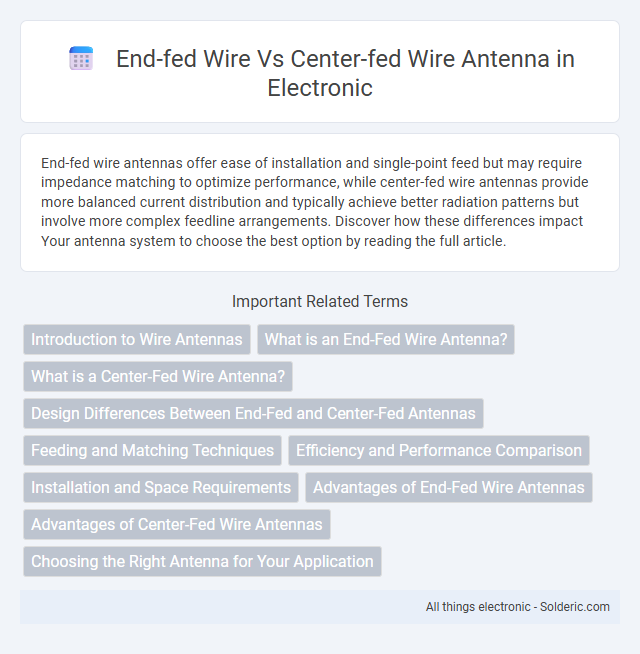End-fed wire antennas offer ease of installation and single-point feed but may require impedance matching to optimize performance, while center-fed wire antennas provide more balanced current distribution and typically achieve better radiation patterns but involve more complex feedline arrangements. Discover how these differences impact Your antenna system to choose the best option by reading the full article.
Comparison Table
| Aspect | End-Fed Wire Antenna | Center-Fed Wire Antenna |
|---|---|---|
| Feed Point | At one end of the wire | At the center of the wire |
| Impedance | High impedance (typically > 2000 O) | Low to moderate impedance (~50-300 O) |
| Matching Requirement | Requires impedance transformer or tuner | Often matches 50 O without transformer |
| Installation | Simple, requires one support point | Requires two support points, physically balanced |
| Radiation Pattern | Unidirectional or end-fire emphasis | Broadside or symmetrical pattern |
| Bandwidth | Narrower bandwidth | Wider bandwidth |
| Length | Typically quarter-wave or multiples | Typically half-wave or multiples |
| Common Use | Portable, stealth, limited space | Base stations, HF amateur radio |
Introduction to Wire Antennas
End-fed wire antennas offer a simple, space-saving design ideal for portable or limited-space applications, utilizing a single feed point at one end which simplifies installation but may require an impedance matching device for efficient operation. Center-fed wire antennas, such as dipoles, provide balanced feed and typically exhibit lower feed-line losses, making them efficient for a wide range of frequencies and commonly used in amateur radio. Both antenna types rely on the principles of electromagnetic radiation in wire elements, with selection influenced by factors like available space, operating frequency, and installation complexity.
What is an End-Fed Wire Antenna?
An end-fed wire antenna is a type of antenna where the feed point is located at one end of the wire, making it easier to install in limited spaces compared to a center-fed wire antenna. It typically requires an impedance matching device or unun transformer to efficiently transfer power from the transmitter to the antenna. Your choice between end-fed and center-fed antennas depends on installation constraints and the desired antenna performance.
What is a Center-Fed Wire Antenna?
A center-fed wire antenna is a type of radio antenna where the feedline connects at the antenna's midpoint, ensuring balanced current distribution and efficient radiation patterns ideal for HF communications. This design reduces impedance mismatch and feedline radiation, providing improved performance across multiple bands when used with an antenna tuner. Your choice of a center-fed antenna often results in better signal clarity and greater overall transmission efficiency compared to end-fed alternatives.
Design Differences Between End-Fed and Center-Fed Antennas
End-fed wire antennas feature a single feed point at one end of the antenna, requiring careful impedance matching often achieved with transformers or tuners, while center-fed antennas have a symmetrical feed at the midpoint, naturally presenting a balanced impedance ideal for antenna tuners. The physical design of center-fed antennas typically involves a balanced feed line such as a ladder line or twin-lead, minimizing losses, whereas end-fed antennas often use coaxial cables and require counterpoise systems for effective operation. These design differences impact installation complexity, feedline choice, and overall antenna performance across frequency bands.
Feeding and Matching Techniques
End-fed wire antennas typically require impedance matching devices such as transformers or LC matching networks to effectively feed the high impedance at the antenna's end, ensuring efficient power transfer from the transmitter. Center-fed wire antennas naturally exhibit lower and more balanced impedance, often close to 50 ohms, allowing direct feeding with a coaxial cable and simpler matching techniques. Feeding methods impact bandwidth and tuning complexity, with end-fed antennas needing careful impedance matching for optimal performance across frequencies.
Efficiency and Performance Comparison
End-fed wire antennas typically exhibit lower efficiency compared to center-fed wire antennas due to unbalanced current distribution and higher feed point impedance, which often necessitates impedance matching devices that introduce additional losses. Center-fed wire antennas provide more uniform current distribution along the elements, resulting in improved radiation efficiency and better overall performance in terms of gain and bandwidth. Performance of center-fed antennas generally surpasses end-fed designs, especially in multiband operations, where balanced feeding ensures consistent impedance and radiation characteristics across frequencies.
Installation and Space Requirements
End-fed wire antennas require minimal space and simple installation as they only need a single support point, making them ideal for limited or confined areas. Center-fed wire antennas demand more clearance and two sturdy support points to ensure proper tension and balance, which can be challenging in small spaces. Your choice depends on available installation space and support structures, with end-fed options offering greater flexibility for compact environments.
Advantages of End-Fed Wire Antennas
End-fed wire antennas offer significant advantages in ease of installation and portability, requiring only a single support point compared to the multiple supports needed for center-fed wire antennas. Their simple feed point design eliminates the need for complex feedline arrangements, reducing the weight and complexity of your antenna setup. This makes end-fed wire antennas ideal for temporary or stealth operations where minimal infrastructure and quick deployment are crucial.
Advantages of Center-Fed Wire Antennas
Center-fed wire antennas offer superior radiation patterns and more efficient power distribution compared to end-fed wire antennas. Their balanced feedpoint allows for easier impedance matching and reduced signal loss, enhancing overall transmission and reception quality. You benefit from improved bandwidth and lower noise levels, making center-fed designs ideal for versatile amateur radio applications.
Choosing the Right Antenna for Your Application
End-fed wire antennas are compact and easy to install, making them ideal for limited space or portable setups, but may require impedance matching devices to achieve optimal performance. Center-fed wire antennas provide a balanced feed point, resulting in better radiation efficiency and easier tuning, suitable for permanent or semi-permanent installations with ample space. Selecting the right antenna depends on your available space, desired frequency range, and installation complexity preferences.
end-fed wire vs center-fed wire antenna Infographic

 solderic.com
solderic.com